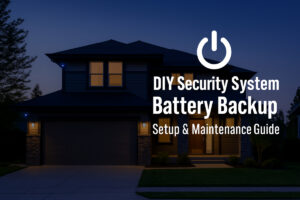Cloud storage has revolutionized smart security systems by providing scalable, off-site data backup, ensuring footage remains accessible even if local devices fail or are stolen.
By leveraging remote servers, homeowners gain real-time access to live and recorded video streams from anywhere, greatly enhancing situational awareness and peace of mind.
Flexible subscription plans let users tailor storage tiers and retention periods to their needs and budgets without large upfront hardware investments.
End-to-end encryption and strict compliance with standards like GDPR and CCPA safeguard sensitive footage both in transit and at rest, maintaining privacy and regulatory adherence.
As leading providers integrate AI-powered analytics and hybrid cloud-local architectures, cloud storage remains the backbone of modern smart home security, delivering resilience, advanced features, and seamless scalability for every user.
Understanding Cloud Storage in Smart Security Systems
In modern security setups, cloud storage underpins remote footage backup, real-time access, and advanced analytics by offloading video to internet-connected server farms (aws.amazon.com).
Providers maintain elastic scalability and disaster recovery across geo-redundant data centers, ensuring uptime and compliance.
Weighted subscription models allow flexible retention and cost management, while TLS encryption in transit and AES-256 at rest protect footage from unauthorized access.
Key benefits include off-site backup, anywhere access, hardware savings, and regulatory compliance.
This section explores the definition of cloud storage and its principal advantages for securing surveillance data.
Definition of Cloud Storage
Cloud storage is a service model that enables storing data and files on remote servers managed by a third-party provider, accessible over the internet through public or private network connections (aws.amazon.com).
These providers maintain the underlying infrastructure—servers, storage arrays, networking, and security—to offer virtually unlimited, elastic capacity without the need for on-site hardware investments.
Key Benefits for Security Footage
Cloud storage transforms how security footage is managed by delivering:
| Benefit | Description |
|---|---|
| Off-site Backup | Protects footage from local damage or theft by storing recordings off-site in secure data centers. |
| Remote Access | Allows live view and playback of recorded clips from any internet-connected device, boosting situational awareness. |
| Scalability | Enables instant adjustment of storage tiers to match data volumes as camera counts or resolution requirements grow. |
| Disaster Recovery | Ensures local and remote site recoveries for uninterrupted security operations, supporting automated failover. |
| Infrastructure Savings | Eliminates large upfront investments in on-premises storage hardware, reducing capital and maintenance costs. |
Industry Insight: 80% of organizations using on-premises servers still leverage cloud storage for at least part of their data protection strategy.
Architecture and Data Flow
Cloud storage for smart security systems hinges on a layered architecture that seamlessly connects edge devices to centralized cloud services.
At the core, high-resolution cameras capture video feeds, local gateways or hubs preprocess and encrypt data, and scalable cloud servers store, index, and analyze footage in real time.
Video upload can be configured for event-triggered alerts—reducing storage needs—or continuous recording to guarantee comprehensive coverage.
To maximize resilience, providers replicate data across geographically distributed data centers, ensuring availability even during regional outages.
Robust security measures employ TLS encryption in transit and AES-256 at rest, aligning with GDPR and CCPA requirements to keep footage private and tamper-proof (aws.amazon.com).
System Components
Smart security setups typically comprise three main components: edge cameras that capture video, local gateways or hubs that manage connectivity and preprocessing, and cloud servers that handle storage and analytics.
Cameras range from battery-powered IoT devices to PoE-connected units, while gateways authenticate devices, buffer data during network interruptions, and enforce initial encryption before forwarding streams to the cloud (aws.amazon.com).
Video Upload Process
Footage can be uploaded either when motion or sound triggers an event or continuously around the clock, each mode serving different security priorities.
Event-triggered uploads conserve bandwidth and storage by sending only relevant clips, whereas continuous uploads ensure no activity is missed but require larger data plans and longer review times.
| Upload Mode | Pros | Cons |
|---|---|---|
| Event-Triggered | Lower storage footprint; faster review | Risk of missed events; false triggers |
| Continuous | Complete coverage; reliable capture | High storage/bandwidth use; time-intensive reviewing |
Table: Comparison of event-triggered vs continuous video upload modes.
Storage Infrastructure & Redundancy
Modern providers store video in multiple, geographically dispersed data centers to guard against outages, data corruption, and hardware failures.
This geo-redundancy ensures that if one region goes offline, footage remains accessible from another location, while load-balancing techniques optimize retrieval speeds for users worldwide.
Retrieval & Playback Mechanisms
Users access live and recorded footage through intuitive web portals or mobile apps, which stream video on demand, support timeline scrubbing, and allow secure downloads or sharing.
Platforms like Videoloft centralize playback, sharing, and analytics in a single interface, enabling both homeowners and security professionals to review critical events with minimal delay.
Security & Encryption Standards
To protect sensitive video data, footage is encrypted in transit using TLS (Transport Layer Security), preventing interception during upload (aws.amazon.com).
Once stored, data at rest is safeguarded with AES-256 encryption, and providers implement strict key management, role-based access controls, and regular security audits to maintain compliance with GDPR, CCPA, and industry best practices.
Cloud Storage Models
Cloud storage for smart security systems comes in four main models—public, private, hybrid, and local-cloud hybrid—each striking a different balance between cost, control, scalability, and resilience.
Public clouds like AWS or Azure offer pay-as-you-go pricing and virtually unlimited capacity but rely on multi-tenant infrastructure and Internet latency considerations.
Private clouds dedicate hardware exclusively to one organization, delivering tight security and compliance oversight at the expense of higher capital and maintenance costs.
Hybrid clouds blend on-premises private storage with public cloud bursting to optimize performance, regulatory adherence, and cost efficiency.
Finally, local-cloud hybrids combine DVR/NVR or NAS devices on-site with cloud backups, ensuring continuous recording even during Internet outages while safeguarding off-site redundancy.
Understanding these models empowers homeowners and system integrators to choose storage strategies that align with security requirements, budget constraints, and operational priorities.
Public Cloud Storage
Public cloud storage uses multi-tenant server farms managed by providers such as AWS, Google Cloud, or Microsoft Azure to store surveillance footage. It offers:
- Low upfront cost: OPEX-only, with pay-as-you-go or tiered plans.
- Elastic scalability: Instant capacity expansion to handle high-resolution streams.
- Shared security responsibility: Providers secure the platform; users manage account and data-level controls.
- Dependency on Internet: Performance and access speeds vary with network bandwidth and SLAs.
| Feature | Public Cloud |
|---|---|
| Cost Structure | Pay-as-you-go; no hardware CAPEX |
| Scalability | Virtually unlimited; auto-scaling |
| Security Control | Shared responsibility model |
| Performance | Internet-dependent; regional latency variability |
| Compliance | Broad certifications (ISO, SOC, HIPAA) |
Private Cloud Storage
A private cloud dedicates infrastructure—either on-premises or in a co-located data center—to a single organization, granting full control over hardware, network, and software stacks. Key characteristics include:
- Maximum security and isolation: No multi-tenant risks; custom security policies.
- Predictable performance: Low latency and guaranteed bandwidth for real-time monitoring.
- Higher upfront investment: Capital expenditure for servers, storage arrays, and maintenance.
- Complex management: Requires in-house or contracted expertise for provisioning and patching.
Hybrid Cloud Storage
Hybrid cloud integrates private and public clouds to let organizations keep sensitive footage on-premises while offloading overflow or archival data to public clouds. Benefits and trade-offs include:
- Regulatory compliance: Store regulated data locally; leverage public cloud for non-sensitive storage.
- Cost optimization: Lower OPEX for archival data, with CAPEX for core high-priority storage.
- Seamless data mobility: Automated tiering between environments.
- Increased complexity: Orchestration across multiple platforms demands robust management tools.
Local-Cloud Hybrid Solutions
Local-cloud hybrids pair on-site devices (e.g., DVRs, NVRs, or NAS units) with cloud backups, ensuring continuous local recording during Internet disruptions and secure off-site redundancy. Key points:
- Resilience to outages: Local storage remains active if the network goes down; pending footage uploads when restored.
- Cost-efficient retention: Cloud used as secondary store, reducing consumption of high-performance local disks.
- Simplified setup: Often integrated by camera vendors or NVR manufacturers for turnkey deployments.
- Balanced control and convenience: Granular on-prem management plus centralized cloud access for remote viewing.
This comparative framework helps stakeholders select the most suitable storage model based on security posture, data sensitivity, budget, and operational needs.
Cost Structures and Pricing Models
Cloud storage pricing for smart security systems varies widely—from consumer-friendly tiered subscriptions with bundled features to enterprise pay-as-you-go models charging per gigabyte and request.
Monthly plans grant flexibility, while annual commitments typically deliver 15–25% savings (e.g., Arlo’s unlimited-camera plan drops from $12.99/mo to $9.99/mo when billed yearly).
Public cloud services like AWS S3 charge $0.022 per GB-month plus per-request and egress fees, offering granular control but complex billing (aws.amazon.com). Retention windows (30–60 days) and hidden fees—such as request charges or fair-use limits—further influence total cost, so readers must weigh predictability against precision when budgeting.
Subscription Tiers: Monthly vs. Annual Plans
Monthly subscriptions provide flexibility without large upfront commitments, but annual plans often reduce the effective monthly rate by up to 25%.
For example, Arlo Secure’s unlimited-camera tier costs $12.99 per month or $9.99 per month when paid annually (a 23% discount).
Ring’s Standard plan is $9.99 per month or $99.99 per year (equivalent to $8.33 per month).
Google Nest Aware starts at $8 per month or $80 per year ($6.67/mo), while Eufy cloud monitoring runs $2.99 per camera each month with no annual option.
| Provider | Plan & Coverage | Monthly Price | Annual Price | Effective Monthly (Annual) |
|---|---|---|---|---|
| Arlo Secure (Unlimited Cameras) | Multi-Camera | $12.99 | $119.88 billed annually | $9.99 |
| Arlo Secure (Single Camera) | Single Camera | $4.99 | $47.88 billed annually | $3.99 |
| Ring Home Standard | Unlimited Devices | $9.99 | $99.99 billed annually | $8.33 |
| Ring Home Basic | Single Device | $3.99 | $39.99 billed annually | $3.33 |
| Nest Aware Basic | All Nest Devices | $8.00 | $80.00 billed annually | $6.67 |
| Nest Aware Plus | All Nest Devices | $15.00 | $150.00 billed annually | $12.50 |
| Eufy Cloud Monitoring | Per Camera | $2.99 | N/A | N/A |
Pay-as-You-Go vs. Tiered Storage Packages
Enterprise-grade platforms like AWS S3 use a pay-as-you-go model, billing $0.022 per GB-month of storage, plus $0.005 per 1,000 PUT and $0.0004 per 1,000 GET requests, and data transfer fees—ideal for precise scaling but potentially unpredictable costs (aws.amazon.com).
In contrast, consumer security providers offer tiered packages at fixed prices, bundling storage, retention, and features into easy-to-understand plans.
| Model | Example Service | Cost Basis | Benefits | Drawbacks |
|---|---|---|---|---|
| Pay-as-You-Go | AWS S3 | $0.022/GB-month; $0.005/1k PUT; $0.0004/1k GET; data egress charges | Highly granular; only pay for actual use | Variable, complex billing |
| Tiered Packages | Arlo, Ring, Nest | Fixed monthly/annual fee for defined storage & features | Predictable budgets; inclusive features | May overpay for unused capacity |
Included Storage Limits & Retention Periods
Cloud plans specify retention windows—how long footage remains in the cloud—often ranging from 30 to 60 days. Arlo Secure’s Basic tier stores recordings for 30 days; after a recent AI-feature update, its Premium plans now extend to 60 days .
Ring Protect and Ring Home subscriptions default to 60 days of video storage.
Nest Aware Basic keeps event-based clips for 30 days, while Nest Aware Plus extends event clips to 60 days and continuous video to 10 days.
Eufy’s cloud options usually span 7–30 days based on activity levels, with free trials offering 14 days of retention.
| Provider | Plan Type | Retention Period |
|---|---|---|
| Arlo Secure Basic | Basic | 30 days |
| Arlo Secure Premium/Plus | Plus & Premium | 60 days |
| Ring Protect & Ring Home | All plans | 60 days |
| Nest Aware Basic | Basic | 30 days (events only) |
| Nest Aware Plus | Plus | 60 days (events) + 10 days (continuous) |
| Eufy Cloud Monitoring | Standard | 7–30 days (plan-dependent) |
Hidden Fees and Overage Charges
Beyond advertised rates, extra costs can arise from exceeding plan limits or service-specific charges. AWS S3 enforces per-request fees ($0.005 per 1,000 PUT, $0.0004 per 1,000 GET) and data egress charges, which may catch high-traffic deployments by surprise (aws.amazon.com).
Consumer services typically avoid overage fees but may apply fair-use policies—Arlo’s guidelines suggest limiting recordings to 15 hours per camera (≈1.6 days) to prevent disproportionate resource usage.
Ring and Nest home plans currently include unlimited requests within their pricing tiers but reserve the right to amend terms for commercial or excessive use.
Always review provider fine print and monitor usage dashboards to avoid unexpected charges.
Top Provider Comparison
Here’s a detailed comparison of the leading consumer and enterprise cloud‐storage options for smart security systems, covering pricing, trials, retention, and key features to help you choose the best fit for your needs.
| Provider | Plan Highlights | Price | Free Trial | Retention |
|---|---|---|---|---|
| Arlo Secure | Unlimited cameras, advanced object detection, Activity Zones | From $6.67/mo billed annually (Basic) | 30-day trial | 30 days video history |
| Ring Protect / Home | Basic event playback, 180-day event history; Premium adds 24/7 CVR for up to 10 cams | Basic: $4.99/mo or $49.99/yr; Premium: $19.99/mo | None (plan activation) | Up to 180 days event history |
| Nest Aware | Unlimited cameras, smart alerts, time-lapse videos | From $8/mo or $80/yr (Basic) | N/A | 30 days (Basic); 60 days (Plus) |
| Eufy Security Cloud | Free local recording + optional cloud backup with dual-backup peace of mind | Optional cloud from $4.99/mo | N/A | 30 days (cloud backups) |
| Enterprise (Verkada Cloud) | Integrated hardware + cloud license, AI analytics, unlimited data for native devices | Custom quotes (license per gateway) | 30-day trial | Unlimited (configurable) |
Arlo Secure
Arlo Secure’s Basic tier covers unlimited cameras and includes advanced Object Detection and Activity Zones. When billed annually, prices start at $6.67 per month, saving ~23% over month-to-month rates.
Every new Arlo device qualifies for a 30-day free trial, activated upon onboarding in the Arlo Secure App. Recordings are retained 30 days by default, with easy export and sharing via the app.
Ring Protect / Home
Ring’s Basic (formerly Protect Basic) plan costs $4.99/month or $49.99/year, offering motion-triggered video playback and up to 180 days of event history.
The top-tier Home Premium plan is $19.99/month, adding 24/7 Continuous Video Recording (CVR) for up to 10 cameras, alongside all lower-tier features. There’s no free trial—plans activate immediately upon purchase.
Nest Aware
Google’s Nest Aware unlocks cloud history for all Nest cameras, speakers, and displays. The entry-level plan is $8/month (or $80/year) for unlimited cameras, smart alerts, and time-lapse videos.
Upgrading to Nest Aware Plus at $15/month (or $150/year) extends event-based retention to 60 days and continuous video to 10 days, making it ideal for deeper investigations.
Eufy Security Cloud
Eufy’s core offering uses free, local recording via HomeBase, while optional Cloud Backup starts at $4.99/month for features like thumbnail previews and off-site retention.
Cloud backups store your videos 30 days off-site, enabling seamless access even if on-premises devices go offline.
This hybrid approach minimizes ongoing fees for most users while safeguarding critical footage.
Enterprise Solutions (Verkada Cloud)
Verkada delivers an integrated hardware + cloud license model, bundling cameras, door controllers, and sensors with AI-driven analytics and access controls.
Cloud licenses are sold per gateway, include unlimited data for Verkada devices (1 GB/mo for third-party), and are priced via custom quotes to fit large deployments. A 30-day free trial lets organizations evaluate the full-featured platform before committing.
Key Takeaways for Buyers
- Budget-conscious DIYers: Ring Basic or Eufy local setup with optional $4.99 cloud add-on.
- Feature-focused consumers: Arlo Secure for unlimited cameras and robust AI alerts.
- Smart-home integrators: Nest Aware for unified Google Home/Assistant experiences.
- Enterprise/Pros: Verkada for turnkey, scalable AI analytics and advanced compliance tools.
This comparison ensures you match your security priorities—be it cost, retention depth, AI features, or enterprise-grade control—with the right cloud-storage model.
Advantages and Limitations
Here’s a concise analysis of the key advantages and limitations of cloud storage for smart security systems, helping you weigh trade-offs when choosing the right solution.
Cloud storage delivers virtually unlimited scalability, automatically provisioning additional capacity as camera counts or resolution needs grow, so you never run out of space.
Its geo-redundant architecture replicates footage across multiple data centers—Backblaze boasts 11-nines durability and a 99.9% uptime SLA—ensuring resilience against hardware failures or regional outages.
However, reliance on subscription plans means ongoing fees can accumulate and may exceed one-time on-premises investments, and latency from internet transmission can introduce multi-second delays in live streaming or playback, potentially hampering real-time response.
Key Advantages (scalability, resilience)
Cloud storage’s elastic infrastructure lets you scale up or down on demand without buying new servers or drives. Whether you add one camera or one hundred, storage grows automatically—no manual provisioning required.
Geo-distributed backups deliver unmatched resilience, protecting footage even if a data center goes offline. Industry-standard “five-nines” (99.999%) availability means under five minutes of downtime per year.
| Advantage | Description |
|---|---|
| Scalability | Auto-elastic capacity: instantly handle growth from a few to thousands of cameras |
| Resilience | Geo-redundant replication ensures “five-nines” availability and protection against localized failures |
Potential Drawbacks (subscription dependency, latency)
While cloud storage cuts upfront hardware costs, its subscription model ties you to monthly or annual fees. Over time—especially with high-resolution or multi-camera setups—these can surpass the one-time expense of on-premises storage.
Even platforms with “pay-as-you-go” billing (e.g. AWS S3 at $0.022/GB-mo plus request fees) can lead to unpredictable invoices without careful monitoring.
Latency remains a concern: internet-based uploads and streaming introduce delays that local storage avoids. Users report multi-second lags in live view and playback, which can hinder rapid incident response.
Moreover, network outages or bandwidth throttling can interrupt uploads and remote access, creating security blind spots when connectivity falters.
This balanced view should help you decide whether the benefits of cloud scalability and resilience outweigh the costs and potential latency of a subscription-based model.
Best Practices and Compliance
Cloud storage compliance in smart security hinges on well-defined retention schedules with automated purging to meet both operational needs and legal mandates, such as purging surveillance footage every 24–48 hours or defining specific 7–14 day windows with documented exceptions.
Under the GDPR, operators must inform affected individuals of recording purposes, retention periods, and responsible parties via clear signage and adhere to EDPB guidelines on proportionality and storage limitation.
The CCPA grants California residents rights to access and delete their personal data—requiring data subject access request (DSAR) processes and responses within 45 days—so cloud platforms must map data flows and enable efficient erasure.
Robust policy management also demands regular audits, documented retention policies, and automated deletion workflows to minimize human error and privacy risk.
Finally, strengthening access controls with two-factor authentication and end-to-end encryption (TLS in transit, AES-256 at rest, or zero-knowledge E2EE) is essential to safeguard footage against unauthorized access and interception.
Data Retention Policies & Automated Deletion
Surveillance operators should establish a clear retention policy that specifies how long video footage is stored—commonly 24–48 hours for routine overwrites or 7–14 days for general monitoring, with longer retention only for investigations or legal holds.
Every policy must document exceptions, such as footage linked to ongoing investigations or restraining order violations, and notify stakeholders appropriately.
Implementing automated deletion workflows reduces manual errors and ensures timely purging. Tools like cloud lifecycle management (e.g., AWS S3 Lifecycle rules) or built-in DVR/NVR settings can automatically delete clips past their retention date, maintaining compliance without administrative overhead.
| Retention Period | Use Case | Automation Tool |
|---|---|---|
| 24–48 hours | High-turnover areas, general patrol | NVR/DVR scheduled overwrite |
| 7–14 days | Standard home/business monitoring | Cloud lifecycle policies |
| Up to 30 days or longer | Incident investigation or DSAR holds | Custom retention rules |
Regulatory Compliance (GDPR, CCPA considerations)
Under GDPR, video surveillance is permissible if it’s proportionate, with no consent required when monitoring is necessary for security, provided that individuals are informed of: recording purposes, retention durations, and data controller details via visible notices.
The EDPB’s Guidelines 3/2019 stress minimization and regular reviews of retention periods to prevent over-storage.
CCPA mandates that covered businesses supply consumers with “right to know,” “right to delete,” and “right to opt-out of sale” provisions. Organizations must integrate DSAR workflows capable of locating and erasing personal data—such as facial recognition metadata or IP addresses—from cloud archives within 45 days (extendable to 90 days under certain circumstances).
| Requirement | GDPR | CCPA |
|---|---|---|
| Notification | Signage: purpose, retention, controller details | Privacy policy update; DSAR instructions |
| Data Subject Rights | Access, rectification, erasure, portability | Access, deletion, opt-out of sale |
| Retention Limitation | Periodic review; automated deletion | Must delete upon request within 45 days |
| Penalties | Fines up to €20 M or 4% global turnover | Fines up to $7,500 per violation |
Enhancing Security (two-factor auth, end-to-end encryption)
Two-factor authentication (2FA) or multi-factor authentication (MFA) is a critical layer to secure cloud management consoles and user portals.
Best practices include using authenticator apps or hardware tokens (e.g., YubiKey) rather than SMS to mitigate SIM-swap risks, rotating 2FA credentials periodically, and enforcing MFA on all administrator and operator accounts.
End-to-end encryption (E2EE) ensures that video remains encrypted from capture to playback, with only authorized endpoints holding decryption keys.
When E2EE isn’t feasible (due to AI analytics needs), implement TLS/SSL for transport encryption and AES-256 for data at rest to guard against interception and unauthorized access.
Zero-knowledge encryption models (such as Dropbox’s E2EE offering) further ensure that even the service provider cannot decrypt user data.
| Security Measure | Recommendation |
|---|---|
| Multi-Factor Auth | Use app-based or hardware tokens; enforce for all admin accounts; rotate credentials regularly |
| Transport Encryption | TLS 1.2+ for all uploads/downloads; enforce HSTS |
| Data-at-Rest Encryption | AES-256 with robust key management; regular key rotation |
| Zero-Knowledge E2EE | When supported, enable full E2EE to prevent provider access |
Adhering to these best practices—comprehensive retention policies, strict regulatory compliance, and robust encryption plus MFA—will help ensure your cloud-based smart security system remains both effective and lawful.
Conclusion
Smart Security System Cloud Storage combines remote, geo-redundant servers to store surveillance footage off-site, providing scalable protection and uninterrupted access even if local equipment fails.
Costs vary from Arlo’s $6.67/mo unlimited-camera plan to AWS S3’s $0.022/GB pay-as-you-go pricing, enabling homeowners to choose between predictable subscriptions and granular billing .
By weighing retention windows, overage fees, and free trial options across top providers, you can find the most cost-effective solution for your security needs .
Ready to bolster your home security with resilient, budget-friendly cloud storage? Compare plans or start a free trial today.
FAQs
What is cloud storage for smart security systems?
Cloud storage stores your security footage on remote servers, ensuring off-site backup and easy access from any internet-connected device.
How much does smart security cloud storage cost?
Costs range from fixed plans—Arlo at $6.67/mo or Ring at $4.99/mo—to usage-based AWS S3 at $0.022 per GB-month.
Which cloud storage model should I choose?
Public clouds offer low entry costs, private clouds provide isolation, hybrid models blend both, and local-cloud hybrids add on-site DVR fail-safes.
How do I ensure GDPR and CCPA compliance?
Implement clear retention policies, automated deletion, visible signage, and a DSAR process to handle data access and deletion requests within required timelines.
What security measures protect my footage?
Use TLS for transport, AES-256 at rest, end-to-end encryption where possible, and enforce multi-factor authentication on all accounts.
Main Tips
- Automate footage deletion to enforce retention policies without manual effort
- Compare monthly vs annual plans to maximize savings on subscriptions
- Use TLS and AES-256 encryption for end-to-end data protection
- Enable multi-factor authentication on all user accounts
- Monitor bandwidth and request usage to avoid hidden overage fees





















